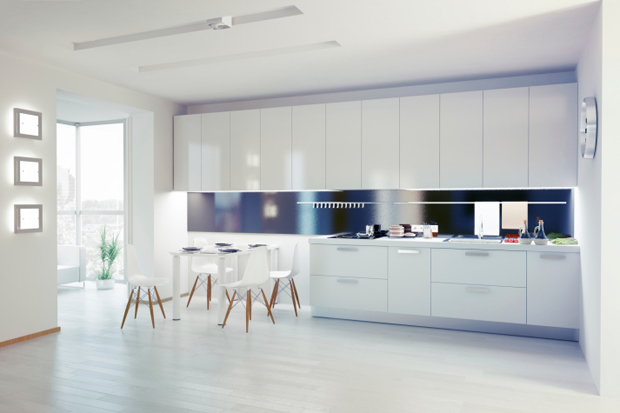‘I love my new kitchen heart of the home let’s fill it with friends happy.’ So says the thought bubble in the current ad for the estate agents Rightmove, part of their ‘Find your happy’ campaign. Don’t even get me started on the lack of punctuation — or the use of ‘happy’ as a noun. What I’m worrying about is the kitchen itself. Glimpsing Ed Miliband’s second kitchen last week, we came face to face with the drabness of today’s hyper-hygienic kitchen. Is the kitchen really ‘the heart of the home’ in Rightmove’s imaginary domestic paradise, or is it in fact one of those spotless, minimalist, metallic kitchens, all hard surfaces and sharp corners? If it is, I fear that the heart has actually been ripped out of the home.
Have you spent time in one of those minimalist kitchens now cropping up in knocked-through basements in the wealthier parts of our cities? I went into one recently and it took me a long time to work out that it was a kitchen. The whole house had been done up at vast expense, and all the rooms looked identical: white floors, white walls, glass-topped tables and matching white laminate cupboards. The only pictures were large studio photographs of the children against a white backdrop.
There was hardly an object to be seen in the white room we sat in. The only giveaway that this was supposed to be the ‘heart of the home’ was a white jug that could have been a kettle. But when I said ‘yes please’ to my hostess’s kind offer of a cup of coffee, she asked her cleaning lady to go round the corner to Starbucks and bring back some skinny lattes.
We perched on white bar stools at the cuboid white island, under a row of dazzling hanging lights that poured heat on to our hair and made the surfaces shimmer. When my hostess had to go out of the room to take a long call on her mobile (they always do, don’t they?), leaving me in the kitchen, there was nothing to do: nothing to look at, nothing to read, not even a bottle of olive oil to contemplate. It was like being in act three of a long play with not enough scenery and not even any dialogue. I had to resort to my own iPhone, scrolling sadly up and down the old emails while gathering static; when eventually I left, I got an electric shock on contact with the industrial-chic metal door handle.
Whatever happened to stuff in kitchens — and to cooking, for that matter? These minimalist kitchens have an air of underuse. Had anyone, I wondered, ever actually cooked red cabbage in this kitchen — braised red cabbage, with its shameless, staining messiness and its lingering brassica pong? Probably not. At most it would be a bit of white sea-bass wrapped in foil and placed in the centre of the integrated Zanussi double-oven.
In the 1970s people used to hide their televisions coyly behind teak cupboard doors. Then, with the onset of the first fitted kitchens, came the urge to hide the evidence that you ever did anything as untidy as eat. In the latest high-end integrated kitchens (the word ‘fitted’ is passé but it means the same thing), this removal of evidence has been carried to its extreme: not only is there no evidence that the inhabitants ever eat or cook, there’s scant evidence that they are even alive.
At least, in those original fitted kitchens of the 1970s, dismal though they were with their Formica surfaces and ill-fitting cupboard doors with the ‘sani-bin’ attached, you might spot a few signs of life: a pepper-grinder perhaps, or a ringbound reporter’s notebook for the shopping list. Nowadays, even those items are banished. Today’s desirable kitchen is totally paperless, except for the kitchen roll that you can’t find. Everything is hidden behind beautiful, fully costed but utterly bland cupboard doors. Just try finding a coffee mug in such a kitchen (as a guest). You open the first cupboard door and discover it’s the dishwasher; the second turns out to hide a gigantic chrome fridge-freezer. You try higher up, and it’s the pulses and lentils.
These kitchens encourage a neurotic culture of cleanliness. No speck of dust must be seen, no splash of milk. Spiders don’t have a chance in such a place, or mice, or normal harmless germs, and that’s probably a good thing: but what about the children? They come home from school longing to sprawl and eat toast, but are told to remove their shoes and not leave a single breadcrumb.
I’m spending many hours in old people’s kitchens at the moment, because I’m researching a book about girls’ boarding schools, which involves interviewing old ladies with long memories. Their kitchens exude character and lived life. They often have a ‘lazy Susan’ in the middle of the worn wooden kitchen table, loaded with jars of marmalade, Marmite and mustard. There’s a kitchen dresser cluttered with bright china, a cat asleep on top of the pile of old newspapers, half an old cake for you to tuck into and a choice of chipped mugs hanging from the mug tree. If these women ever left you alone while they answered the phone (which they don’t, as they’re too polite and don’t much use their mobiles), you would be happily entertained.
Minimalist kitchens have the acoustics of a deafening restaurant, there being nothing soft (not even a tea-towel, a napkin or a banana, let alone anything as old-fashioned as curtains — it’s all shutters) to absorb the sound. Also (have you noticed?) there are never quite enough bar stools to go round. At any time in the average family kitchen there might be six or seven people hanging around hoping for something to eat. The architects of the kitchen only stipulated two (or at the most four) bar stools, so half the people have to stand, resting elbows wearily on the island.
What is this bar-stool addiction, anyway? I do see that work surfaces need to be higher than tables — hence the island-height and the need for something high to sit on. But bar stools are not as comfortable as chairs, and are unsuitable for visiting grandparents who need to be helped on and off them. I suppose this is part of the point: bar stools flaunt the youth and success of their owners; no time to sit down properly, as you only have time for a quick espresso before going off to make or spend money.
A telling headline appears in the current edition of the free glossy London magazine SW Resident, whose pages are full of photos of new-style minimalist kitchens: ‘Plan your kitchen carefully and it could last you a decade.’ A decade! Exactly as long as the latest combi-boilers which are designed to last no more than ten years. This shows what kitchens have become: fashion statements. Change your wardrobe every year; change your boiler and in fact your whole kitchen every ten. I like to think that even the jar of Marmite on the old boarding-schoolgirl’s lazy Susan is at least two decades old.
Got something to add? Join the discussion and comment below.
Get 10 issues for just $10
Subscribe to The Spectator Australia today for the next 10 magazine issues, plus full online access, for just $10.
You might disagree with half of it, but you’ll enjoy reading all of it. Try your first month for free, then just $2 a week for the remainder of your first year.














Comments
Don't miss out
Join the conversation with other Spectator Australia readers. Subscribe to leave a comment.
SUBSCRIBEAlready a subscriber? Log in